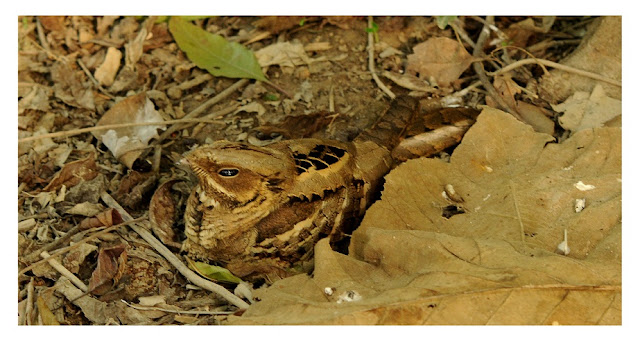 |
| The Large Tailed Nightjar wrapped up in silence. Notice the white frill on the throat; in some individuals it is supposedly prominent enough to be called a throat patch |
The sound spills out, and none of it is lost. The whole wood brims with it. Then it stops. Suddenly, unexpectedly. But the ear hears it still, a prolonged and fading echo, draining and winding out among the surrounding trees".
- J.A. Baker (The Peregrine)
 |
| The peafowl feather that led us to the nightjar |
It was a nice November afternoon, hotter than usual, and I along with four kids, including two of my own, was looking for bird feathers in an overgrown corner of the garden. I located a peacock feather, not the regular ornate one that Krishna prefers but one from the bird's flanks – a lovely feather with alternating bands of white and darkest grey. As I proceeded to inform everyone the name of the feather’s owner a voice called out from the deepest bushes.
Voice from the bushes: “This feather does not belong to the peacock”
Me: “Then?”
Voice from the bushes: “It belongs to a brown bird!”
Me: (Convinced he has seen a Peafowl fledgling) “It’s the young one you are looking at.”
Voice from the bushes: “No, it flew.”
Peafowl fledglings do not fly. They make a beeline behind their mother and tirelessly move about the garden, in perennial awe of the marvelous world around them. So that’s what we had - a brown bird that flew from the ground under the bushes one fine November noon!
 |
| Excellent camouflage - the bird is strongly patterned yet merges with the leaf litter |
I did not have to wait long. The very next day as I walked down a garden path, crunching leaves underfoot, a pigeon-sized brown bird took off from near my feet. Before I could recover and take the next step another flew. Then another. It suddenly dawned on me that I had seen my first nightjar, specifically the Large-tailed Nightjar (Caprimulgus macrurus) by inadvertently disturbing its roost. Henceforth, the afternoons were occupied.
It soon became clear that the nightjar preferred regular roosts. Also, if disturbed, it flew in pre-set hops to other roosts. So, actually, it had a few favorite roosting spots. Every afternoon I would know I could look for it at any of the four locations and if I was careful enough, it allowed a close enough approach for naked eye observation. There was something mesmerizing about the way it sat crouched amidst the litter. Never did it ever betray a slightest hint of movement, not even a blink of its eye. Neither did it take undue alarm at my approach (except when I got too close it flew to another of its roosts). The camouflage was perfect – if I did not know it was there, I could never have located it except when it flew. Quite often I would scan a roost knowing it is around and miss it completely. The silence it wrapped itself in made the camouflage perfect.
The first thing that struck me was its flight. Except for the sharp rustle of the dry leaf litter at takeoff the flight was absolutely silent. It was not slow, it was quick enough for a getaway but as the feathers cut the air there was no audible sound – no swoosh, rustle or whisper. The flight itself was a bit awkward – like a drone dipping sideways, alternating on each side, revealing prominent white wingbars -- which really are the buff tips of the coverts. The noontime flights were always short – they were more like quick darts to another roost.
Usually, as soon as the bird took off, it quickly gained height and descended to another roost barely 50-70 m away, most often on the other side of a wall or barrier, but sometimes below another bush and occasionally in the open but always in abundant leaf litter. Sometimes, it perched briefly on a branch, always along its length (never crosswise) and then quickly descended to roost. So eager was it to get to a roost that, occasionally, it descended too soon, discovered a barrier and had to turn sharply to evade it.
 |
| The beautiful liquid eye, the thin broad bill and the whiskers |
Other times the bird remained quiet, well concealed and well camouflaged, but looking out with large, oval liquid eyes, which certainly gave it excellent peripheral vision and remained ever open. The wide gape of the bill reminded me of the Frogmouth, as also the small whiskers near the beak -- which was wafer-thin and enormously broad at the base, resembling an equilateral triangle.
 |
| The breast has a neat parting and a mottled appearance. The buff edges of the scapulars create the side wing-bars. |
The roosts were all in well-sheltered places -- the sort of nooks where one might walk past without peering in.
 |
| This roost is against a masonry wall and below a thick bush. There is no approach from three sides. |
 |
| A neat nook amid reeds - thick vegetation covers it almost entirely. The Nightjar was in the small cave-like opening in the middle. |
 |
| Against an overgrown bank -- this was my best view. The first and the third picture from the top are from this roost. |
 |
| This may be a nigh jar feather -- can't be certain, though. Any guesses? |
Read all Encounter posts on The Green Ogre




